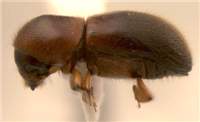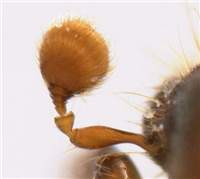Diagnosis
Most of body covered with dense pubescence and very abundant minute punctures. Pronotum and elytra rounded, with no conspicuous edges or carinas. Antennal club type 3 or 4, with segment 1 concave or reduced on both sides, most of the club pubescent.
Some smaller elongated species difficult to distinguish from Truncaudum sp. especially T. agnatum. The latter differs by larger tubercles on the elytral declivity.
Distribution
Worldwide except South America. One species recently introduced to Europe, two to North America.
Biology
General ambrosial habits, host generalists, most species in branches rather than trunk.
Taxonomy
Relationships not clear, probably relater to Arixyleborus and Truncaudum.
Detailed description
Eyes often deeply emarginate, sometimes almost disjunct, upper portion of eyes as large as lower part. Antennal club mostly broader than tall, club type three (with segment 1 straight or convex), or four (segment 1 small, second and third prominent on both sides). Segment 1 of club straight (may be slightly concave or convex) on anterior face, or convex, small, margin of segment 1 mostly costate, may appear softer on posterior side. Segment 2 corneous, visible on anterior side only, or corneous on both sides of club, but not circular (not making antenna "telescopic"). Segment 3 clearly visible on both sides of club. Segment 1 of antennal funicle shorter than pedicel, funicle 4-segmented, scapus regularly thick. Frons above epistoma rugged, coarsely punctate, rounded from lateral view. Submentum deeply impressed, shaped as very narrow triangle. Pronotal anterior edge with small elevated serrations or bare, never with prominent elevated costa with serrations. Pronotum from lateral view of basic shape (type 0), or tall (type 2), or inflated anteriad (type 4), or rounded and robust (type 5), rarely elongated, with low summit (type 7). From dorsal view it is basic, short, parallel-sided, rounded frontally (type 2). Pronotal disc shining or smoothly alutaceous, with dense small punctures, always with dense setae, lateral edge of pronotum obliquely costate. Procoxae contiguous, prosternal posterocoxal process short and conical, or flat and inconspicuous, or tall and pointed, or conical and slightly inflated. Neither pronotal nor elytral mycangium present, but rich vestiture on pronotal basis may be mistaken for mycangial tuft. Scutellum flat, flush with elytra. Elytral bases straight, with oblique edge, elytral disc longer than declivity, flat or convex, punctures on elytral disc sometimes in strial lines, but mostly confused. Boundary between elytral disc and declivity distinct or indistinct, disc often convex, smoothly transitioning into declivity. Lateral profile of elytral declivity ranging from flat to rounded, rarely steep, especially towards apex, in one rare case excavated. Dorsal profile of elytral apex rounded. Elytra almost always richly pubescent, hair more abundant than strial punctures. Posterolateral declivital costa absent or indefinable, or very short, only in one rare species distinctly elevated. Pattern of tuberculation on declivity very variable: surface of declivity with no tubercles, or with uniform granules, or no tubercles on interstria 2, and several tubercles on interstriae 1, 3 and beyond, or abundant and oblique tubercles in all interstriae. First interstriae usually parallel, sometimes slightly broadened towards elytral summit, or parallel on disc but broadened towards apex of elytra. Protibiae with evenly rounded edge. Posterior side of protibia flat, no granules, only setae, or inflated and granulated. Protibial denticles small to minute, bases of denticles not enlarged, protibial margin rounded, usually between 6 and 8 protibial denticles present. Femora appear large and robust. Body usually bulky and rounded, length 2.2-5.5 mm. Uniformly light or dark brown to black. Most of body covered with faint pubescence and abundant, minute punctures.



